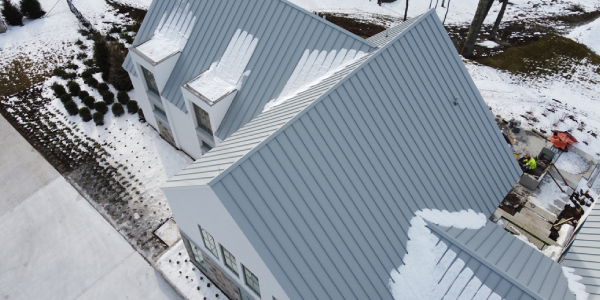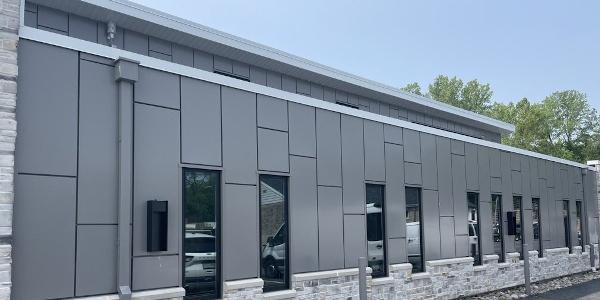UP TO THE MINUTE
5 steps to ensuring a metal roof is ready for winter
January 3, 2025 at 8:00 a.m.By Drexel Metals.
With proper care and winterization, a metal roof provides some of the best and most long-lasting protection from the elements.
Editor’s note: Share the following information on winterizing a metal roof with your clients.
Metal roofs create a beautiful, modern aesthetic for your home while also providing the added benefits of energy-efficiency and durability. But these benefits can only be fully realized when the roof is cared for properly. This becomes especially apparent in the winter months, which are tough on any type of roof.
In areas that get winter storms, the snow and ice can wreak havoc on the roof. For traditional shingled roofs, this type of strain can damage a roof’s integrity. For example, if one shingle gets damaged, the entire roof system is compromised and moisture may seep into your home. Metal roofs do not have this same issue and are actually designed for durability and withstanding these types of strains. However, they still need to be properly cared for so they can perform their best. Check out these steps from Drexel Metals about winterizing a metal roof.
1 - Visually inspect the roof for damage
Inspecting a roof for damage can reveal potential issues before they cause long-term problems. Even though metal roofs tend to be more resilient than other competitive options (lasting up to three times longer than asphalt shingles), they are not completely invulnerable to damage. The danger for damage can increase in the winter since freeze-thaw cycles can exacerbate the risks created by moisture penetrating roofing materials.
Looking for marred panels, flashings and seams can help affirm that a roof will provide optimal protection against winter weather. Although homeowners can take this task on by themselves, seeking a professional’s opinion can help ensure a thorough and accurate assessment of the roof’s integrity.
2 - Add snow guards
Metal roofs shed snow quickly and efficiently. This benefit can be dangerous during heavy snowfall — since large clumps of snow and ice can slide from a roof without warning. Falling ice could damage gutters and shrubbery or even cause injury.
Snow guards regulate the rate at which roofs shed snow and ice, so installing them can mitigate the risk of property damage and personal injury. But not all snow guards are equal. ColorGard® has unsurpassed holding strength and color-matching. It is also warranted for the life of the roof it guards.
3 - Trim trees overhead
While snow guards regulate snow shedding, they can also catch fallen branches, which make even the most stunning roof look a little unsightly. Trimming overhead branches helps sideline debris from collecting on the roof (and in gutters).
It also helps prevent damage that may happen when a large branch strikes a roof. With the added strain of heavy snow, branches may be more likely to fall in the winter. And if one strikes a roof with enough force, it could cause damages that may not be immediately noticeable. By trimming branches, homeowners can reduce the risk of damage from falling debris before it happens.
4 - Clean the gutters
If the trees surrounding the house need trimming, chances are the gutters also need cleaning. Debris can collect in gutters and reduce their ability to control the flow of water from a roof. In the warmer months, this can lead to leaks and foundation issues. Clogged gutters become dangerous in winter due to ice damming. For example, if ice and snow slowly melt and then pool in a clogged gutter, it can refreeze, accumulating more ice until the weight causes the gutter to fall.
Cleaning the gutters helps mitigate all these issues and is an easy way to ensure a roof will stay strong and intact in the harshest weather.
5 - Check the attic’s insulation
Even though metal roofs can quickly shed snow, ice dams can still form if the roof is not properly insulated from below. As heat radiates through the attic and out of the roof, it can melt the snow, causing it to trickle and refreeze along the eaves and gutters. This creates dangerous ice dams whose weight can damage gutter systems. Ice dams can also fall suddenly — posing a serious risk of injury for those standing below.
To protect against this, properly insulating the attic-side of a roof can help prevent temperature fluctuations and reduce the potential for ice dam formation. By following insulation recommendations by region, homeowners can also reduce the energy needed to keep their homes at a comfortable temperature year-round.
Original article source: Drexel Metals
Learn more about Drexel Metals in their Coffee Shop Directory or visit www.drexmet.com.





















Comments
Leave a Reply
Have an account? Login to leave a comment!
Sign In